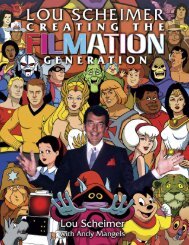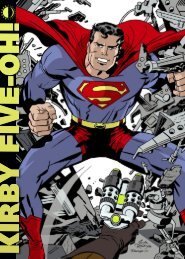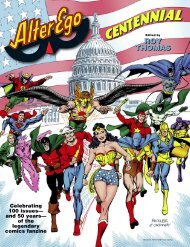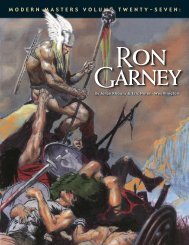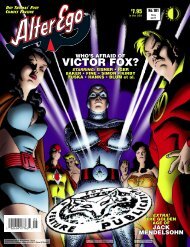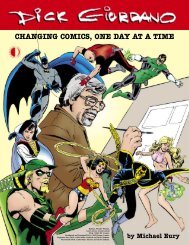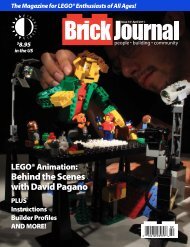Matt Baker: The Art of Glamour - TwoMorrows Publishing Store
Matt Baker: The Art of Glamour - TwoMorrows Publishing Store
Matt Baker: The Art of Glamour - TwoMorrows Publishing Store
Create successful ePaper yourself
Turn your PDF publications into a flip-book with our unique Google optimized e-Paper software.
Andrew Loomis as well as such prominent comic-book artists<br />
like Will Eisner, Reed Crandall, and Lou Fine. Although he<br />
never managed to work together with the latter ones, <strong>Baker</strong><br />
started his comics career at the studio run by the man who<br />
had been Eisner’s partner, as well as Crandall’s and Fine’s coemployer,<br />
up until late 1939, Samuel Maxwell (“Jerry”) Iger<br />
(1903–1990). As Iger himself recalled, “[<strong>Baker</strong>] came to my<br />
studio in the early ’40s; handsome and nattily dressed, ‘looking<br />
for a job’, as he put it. His only sample was a color sketch<br />
<strong>of</strong>—naturally—a beautiful gal! On the strength <strong>of</strong> that and a<br />
nod from my associate editor Ruth Roche, he was hired as a<br />
background artist. … When given his first script, he showed<br />
originality and faithfully executed its story line. His drawing<br />
was superb. His women were gorgeous!” 1<br />
Although in <strong>The</strong> Iger Comics Kingdom (1985) Jay Disbrow<br />
writes that <strong>Baker</strong> joined the Iger studio “early in 1946,” it<br />
is evident that he was already working on staff at the <strong>of</strong>fice<br />
located at 250 West Broadway in 1944. In fact <strong>Baker</strong>’s earliest<br />
documented art appeared in Jumbo Comics #69 (November<br />
1944), published by Thurman T. Scott’s Fiction House,<br />
which was Iger’s best client from 1938–53.<br />
<strong>The</strong> Early Iger Years<br />
as other “comic shops” <strong>of</strong> the time, the Iger Studio provided<br />
story and artwork to different comic-book titles issued<br />
by different publishers, including Crown, Fiction House,<br />
Fox, Green, and Gilberton, to name a few. As in other comic<br />
shops, art chores on the same story were <strong>of</strong>ten shared by different<br />
artists, and at the start <strong>Baker</strong> apparently penciled backgrounds<br />
and female characters for other studio staffers. Thus,<br />
his earliest efforts are <strong>of</strong>ten hidden within somebody else’s<br />
artwork—namely Alex Blum’s and Robert Hayward (Bob)<br />
Webb’s—mostly in the “Sheena, Queen <strong>of</strong> the Jungle” stories<br />
published by Fiction House in Jumbo Comics during 1944–<br />
45. Blum—a former painter/muralist who was twice <strong>Baker</strong>’s<br />
age, having been born in 1889—was kind <strong>of</strong> the dean at the<br />
Iger Studio. Acting as an art director during the early 1940s,<br />
Blum was an early inspiration for <strong>Baker</strong>, who also occasionally<br />
teamed with him on “Wambi the Jungle Boy,” which appeared<br />
in Jungle Comics.<br />
In fact, <strong>Baker</strong>’s apprenticeship did not last long. By mid-<br />
1944 he was able to stand on his own feet and had become<br />
the resident artist on “Sky Girl,” a regular feature in Fiction<br />
House’s Jumbo Comics. Script-wise, “Sky Girl” was attributed<br />
to “Bill Gibson,” one <strong>of</strong> the many bylines used at the Iger<br />
Studio behind which hid different writers, including Iger<br />
himself. <strong>The</strong> titular character, whose real name was Ginger<br />
Maguire, was a curvaceous, red-haired Irish girl (reportedly<br />
based on actress Ann Sheridan) whose early, semi-serious adventures<br />
took place mostly in the Pacific theater, where she<br />
acted as a ferry pilot, <strong>of</strong>ten helping out Air Force aviators on<br />
missions against the Japanese.<br />
<strong>The</strong> evolution <strong>of</strong> <strong>Baker</strong>’s style from his early phase to a<br />
more personal post-war approach somewhat paralleled the<br />
A sample <strong>of</strong> <strong>Baker</strong>’s “Sky Girl” work from 1945.<br />
evolution <strong>of</strong> “Sky Girl.” <strong>The</strong> splash-page caption to the “Sky<br />
Girl” story in Jumbo #87 (May 1946) read: “<strong>The</strong>y mustered<br />
Ginger Maguire out <strong>of</strong> uniform, but they couldn’t muster<br />
her away from flying… Yet the nearest she can get to flying<br />
now is an airfield cafeteria, serving mustard to the better<br />
class <strong>of</strong> pilots!” With Ginger demoted and working as a<br />
waitress, the strip now decidedly veered towards comedy.<br />
Ever wishing she could go back to her previous pilot status,<br />
Ginger did manage to fly again, yet she was more <strong>of</strong>ten seen<br />
hanging from planes’ wings rather than holding the control<br />
stick, in a whole series <strong>of</strong> predicaments whose ill-concealed<br />
purpose was to allow <strong>Baker</strong> to highlight the girl’s long legs,<br />
regularly uncovered by pitiless turbulence to the delight <strong>of</strong><br />
male readers.<br />
Ginger’s legs were the real plus in these stories. <strong>Baker</strong> drew<br />
them from every conceivable angle, in positions that were<br />
<strong>of</strong>ten ungainly. Deliberately so. In fact, <strong>Baker</strong> was the first<br />
comic artist who had the courage to draw a beautiful pair <strong>of</strong><br />
legs in an unaesthetic if natural way to increase the general<br />
humorous effect. Needless to say, he was hugely successful.<br />
<strong>Baker</strong>’s last “Sky Girl” story appeared in the August 1948<br />
issue <strong>of</strong> Jumbo.<br />
MEET MATT BAKER<br />
37




